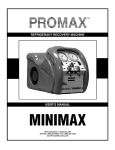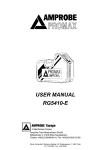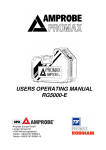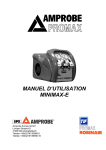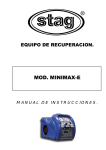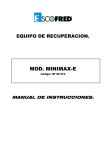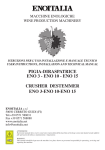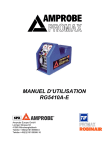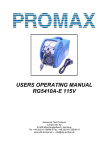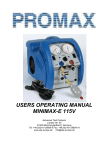Download RobinAir 25176B User's Manual
Transcript
100439_RevC.qxd 9/2/05 3:02 PM Page 1 REFRIGERANT RECOVERY SYSTEM USER’S OPERATING MANUAL 25176B 100439_RevC.qxd 9/2/05 3:02 PM Page 2 TABLE OF CONTENTS IMPORTANT SAFETY INFORMATION OPERATING GUIDELINES 4 5-6 CARE AND MAINTENANCE OF YOUR 25176B ADDITIONAL RECOVERY TANK INFORMATION PURGING NON-CONDENSABLE GASES HELPFUL HINTS FOR REFRIGERANT RECOVERY OPERATING YOUR 25176B DIAGRAM FOR REFRIGERANT RECOVERY SELF PURGING YOUR 25176B SELF PURGE/AUTO EVACUATE DIAGRAM FOR “PUSH/PULL” METHOD 6 7 8 9-10 11 11 12 12 13 SET-UP DIAGRAM FOR TANK PRE OR SUB COOLING PROCEDURE 13 OPTIONAL RECOVERY / TANK PRE OR SUB COOLING FOR FIXED HOSE SET-UP 14 REFRIGERANT FLOW DIAGRAM 25176B PARTS DIAGRAM/PARTS AND ACCESSORIES LIST 25176B AND 25176B-KT WIRING DIAGRAMS 15 16 17 INSTALLATION OF OPTIONAL 80% TANK CAPACITY SENSING COMPONENTS (KIT KT-5001) 25176B-KT MODEL TROUBLESHOOTING YOUR 25176B FULL ONE YEAR WARRANTY ENVIRONMENTAL PROTECTION AGENCY (EPA) INSTRUCTIONS 18 18 19 20 21 EPA REGIONAL OFFICES 22 3 100439_RevC.qxd 9/2/05 m 3:02 PM Page 3 IMPORTANT SAFETY INFORMATION m SAFETY COMES FIRST! Read all safety, operating guidelines and instructions before operating your 25176B. 8. 1. CAUTION: ONLY A QUALIFIED TECHNICIAN SHOULD OPERATE THIS RECOVERY UNIT. The operator must be familiar with air conditioning and refrigeration systems, refrigerants and the dangers of pressurized components. 9. If you expect temperatures in excess of 135° F, contact the refrigerant supplier. 10. Be sure that any room where you are working is thoroughly ventilated, especially if a leak is suspected. Refrigerant vapor is hazardous to your health and can cause death. 2. Always think before acting, familiarity breeds carelessness and carelessness can be harmful to your health or, worse, result in death. 3. m WARNING Always wear safety goggles and 11. m PRESSURIZED TANK CONTAINS LIQUID 12. • When using an extension cord it should be a 3-wire, 14 AWG minimum and no longer than 25 feet. m Warning: DO NOT: Exceed the working pressure of each cylinder. Recovery cylinders are designed for different pressures. Your 25176B is not supplied with a recovery tank, it requires the use of tanks with a minimum of 350 psi working pressure and ROBINAIR strongly recommends the use of 400 psi tanks. • Use this equipment in locations with mechanical ventilation that provides at least four air changes per hour or locate the equipment at least 18 inches above the floor. • Never use oxygen when testing for leaks. Any oil in contact with oxygen under pressure will form an explosive mixture. NOTE: The use of a 400 psi tank is mandatory when recovering R410A. See ROBINAIR Recovery Tanks under Parts and Accessories section on Page 16. 6. i WARNING: TO REDUCE THE RISK OF FIRE: • Never operate unit in an explosive environment! Do not use this equipment in the vicinity of spilled or open containers of gasoline or any other flammable liquid. REFRIGERANT. NEVER OVERFILL STORAGE TANKS. OVERFILLING OF THE TANK MAY CAUSE A VIOLENT EXPLOSION AND POSSIBLE INJURY OR DEATH. DO NOT: Exceed the working pressure of Recovery Tank cylinder. 5. m Avoid breathing A/C refrigerant and lubrication vapor or mist. Exposure may irritate eyes, nose and throat. If accidental system discharge occurs, ventilate work area before resuming service. protective gloves when working with refrigerants. Contact with refrigerant may cause injury. Disconnect hoses with extreme caution! All hoses may contain liquid refrigerant under pressure. 4. Read all safety information regarding the safe handling of refrigerant and refrigerant oil, including the Material Safety Data Sheet. MSDS sheets can be obtained from your refrigerant supplier. 13. c High voltage electricity inside panels. Risk of electrical shock. Be sure to disconnect the unit from the power source before servicing it. m A scale must be used to avoid overfilling the 14. To reduce the risk of injury, care should be taken when moving this equipment. storage tank. DO NOT OVERFILL. Tank is full at 80% volume. Tank may explode if filled more than 80% due to liquid expansion. 7. Use ONLY authorized refillable refrigerant tanks. NEVER use a standard disposable 30lb. tank (the type of container in which virgin refrigerant is sold) to recover refrigerant. 4 100439_RevC.qxd 9/2/05 3:02 PM Page 4 OPERATING GUIDELINES m Before operating the 25176B recovery unit, read the following m 9. storage tank. DO NOT OVERFILL. Tank is full at 80% volume. Tank may explode if filled more than 80% due to liquid expansion. Below is a representative sample for R-22 refrigerant: 1. 25176B IS APPROVED FOR USE WITH THE FOLLOWING CATEGORY III, IV and V REFRIGERANTS (Per ARI 740): R-12, R-22, R-134A, R-401A, R-401B, R-401C, R-402A, R-402-B, R-404A, R-406A, R-407A, R-407-B, R-407C, R-407D, R-408A, R-409A, R-410A, R-411A, R-411B, R-412A, R-500, R-502, R-507 and R-509 TANK SIZE 30 lb. Tank 50 lb. Tank 2. A FILTER must always be used and should replaced frequently. We recommend that a clean filter be used for every service job. Failure to use a filter will invalidate your warranty. MAX NET WEIGHT 24 lbs. 40 lbs. Note: Robinair strongly recommends the use of the ADS-100 Refrigerant Scale for monitoring tank capacity. 10. Your 25176B has an Internal Pressure Shut Off Switch. If the pressure inside the system should go above 470 psi, the system will automatically shut itself off. The shut off switch will automatically reset itself again after the pressure drops below 300 psi. The use of a filter will greatly reduce the risk of damage to your 25176B, by preventing foreign material from entering the unit. 3. Each filter should be labeled and used exclusively for one type of refrigerant only. 4. Always open service and cylinder valves slowly. This allows rapid control of the flow of gases if there is any danger. Once it is determined that there is no danger, the valves can be opened fully. m WARNING: The Internal Pressure Shut Off Switch does not prevent tank overfill. If your system shuts off on high pressure and is connected to your tank, you may have overfilled your tank and created a very dangerous situation! Take immediate measures to relieve any high pressure and/or tank overfill. 5. Always isolate large amounts of refrigerant and close off valves after use, so if a leak should develop anywhere in the system, the refrigerant will not escape. 11. When recovering large amounts of liquid, use the "Push/Pull method (see diagram on page 13). m CAUTION: When using the "Push/Pull" method, once the "Push/Pull" siphon is started, it can continue and overfill the storage tank even if the tank is equipped with a "shut off" float sensor. The siphon can continue even after the machine is turned off. You must manually close the valves on the tank and the unit to prevent overfilling of the recovery tank. 6. Keep all connections to the refrigeration system thoroughly dry and clean. If moisture enters the refrigeration system, it is likely to cause considerable damage. 7. Robinair strongly recommends the use of the optional 80% Capacity Shutoff Kit (p/n KT-5001). When installed and used with a recovery tank that has an internal float switch, the 25176B will shut down automatically when the tank is 80% full. Your 25176B is pre-wired from the factory for this kit. Note: The 25176B is also available in model 25176BKT, with the 80% Shutoff Kit installed direct from the factory. 8. m A scale must be used to avoid overfilling the 12. Always operate the unit on a flat level surface 13. To achieve the deepest final vacuum, use the tank cooling method to lower the head pressure on the recovery tank. (See Pages 13 &14). Repeat as necessary to achieve the desired vacuum level. m CAUTION: Use only authorized refillable refrigerant recovery tanks. Federal regulations require refrigerant to be transported only in containers meeting DOT spec. 4BA or 4BW. NEVER use a standard disposable 30lb. tank (the type of container in which virgin refrigerant is sold) to recover refrigerant. 5 100439_RevC.qxd 9/2/05 3:02 PM Page 5 OPERATING GUIDELINES - cont. NOTE: If there is no liquid in the recovery tank, then the cooling method will not work. In this case, use an empty tank that has been fully evacuated to achieve the final vacuum level required. 15. To maximize recovery rates, use the shortest possible length of 3/8" or larger hose. A hose no longer than 3 feet is recommended. 16.For maximum throughput, always remove all unnecessary hose core depressors and the Schraeder valves from port connections. 17.Deformed rubber seals and core depressors in hoses and faulty or unnecessary Schraeder valves can restrict flow up to 90%. 14. If the tank pressure exceeds 300 psi, use the tank cooling procedure to reduce the tank pressure. (See Pages 13 & 14) CARE AND MAINTENANCE OF YOUR 25176B 1. USE of a filter/dryer at the inlet is mandatory. A filter/dryer must always be used between the recovery machine and the inlet hose. 2. Special care should be taken when recovering from a "burned-out" system. Use two high acid capacity filters, in series. (Alco type EK-162-F or Sporlan type C-162-F are recommended )When you have finished recovering from the system, flush your 25176B with a small amount of clean refrigerant and refrigerant oil to purge off any foreign substances left in the unit. 3. Always empty refrigerant from the 25176B into a storage tank; see Self-Purge/Auto Evacuate procedure on Page 12. Liquid refrigerant left in the 25176B’s condenser may expand, causing damage to components. 4. c Warning! Whenever you perform any type of maintenance work on your 25176B, insure that it is disconnected from the power supply before you begin. 5. If the unit is to be stored or not used for any length of time, we recommend that it be completely evacuated of any residual refrigerant and purged with dry nitrogen. 6 100439_RevC.qxd 9/2/05 3:02 PM Page 6 ADDITIONAL RECOVERY TANK INFORMATION m Warning: Also read the information pertaining to recovery tanks, previously listed under Safety Information and Operating Guidelines. 3. Tanks and filters should be designated for one refrigerant only. Before using a tank previously used for another refrigerant, completely empty the tank, evacuate it and purge the tank using dry nitrogen, and then re-evacuate it. 1. CAUTION: NEVER use a standard disposable 30lb. tank (the type of container in which virgin refrigerant is sold) to recover refrigerant. Use ONLY authorized refillable refrigerant tanks. Federal regulations require refrigerant to be trans ported only in containers meeting DOT specs. 4BW or 4BA. 4. Always store refrigerant containers in a cool dry place. 5. Do not mix refrigerants in a system, a tank or any where else. Each type of refrigerant must have its own tank, filter, etc. 2. m Warning: DO NOT: Exceed the working pressure of each cylinder. Recovery cylinders are designed for different pressures. Your 25176B is not supplied with a recovery tank, it requires the use of tanks with a minimum of 350 psi working pressure and ROBINAIR strongly recommends the use of 400 psi tanks. NOTE: The use of a 400 psi tank is mandatory when recovering R-410A. See ROBINAIR Recovery Tanks under Parts and Accessories section on Page 16. 6. Storage cylinders sometimes have valves that are not properly seated when manufactured. Keeping caps on these valves will guard against refrigerant leakage. 7. Do not exceed 80% of tank capacity. ROBINAIR strongly recommends the use of the ADS-100 Refrigerant Scale for monitoring tank capacity. Safety codes recommend that closed tanks not be filled over 80% of volume with liquid. The remaining 20% is called head pressure room. 8. If you expect temperatures in excess of 135° F, contact the refrigerant supplier. m NEVER TRANSPORT AN OVERFILLED CYLINDER m Refrigerant expands when it gets warm and may cause a tank to explode if overfilled. CYLINDER TEMPERATURE 60°F 70°F 100°F 130°F 150°F 80% 81% 83% 90% 94% 90% 92% 96% 100% STARTING WITH CYLINDER 80% BY VOLUME SPACE OCCUPIED BY LIQUID STARTING WITH CYLINDER 90% BY VOLUME SPACE OCCUPIED BY LIQUID 7 100439_RevC.qxd 9/2/05 3:02 PM Page 7 PURGING NON-CONDENSABLE GASES FROM REFRIGERANT TANK 1. Allow the tank to sit undisturbed for 24 hours. This allows the air to rise to the top. 5. If the pressure reading is higher than the pressure shown on the chart, very slowly (so as not to cause turbulence inside the tank) crack open the vapor port valve. Watch the pressure on the gauge decrease. To prevent venting, add 4-5 psi to the pressure shown on the chart. when the gauge corresponds to that pressure, close the vapor port valve. 2. Connect a manifold to the tank and read the amount of pressure in the tank by looking at the output pressure gauge. 3. Determine the ambient temperature in the room. 4. Refer to a Refrigerant pressure/temperature chart. Find the temperature on the chart and look across to the corresponding pressure for the type of refrigerant in the tank. Determine how that relates to the reading on the gauge. 6. Allow the tank to sit for 10 minutes and check the pressure again. 7. Repeat the process again if necessary. 8 100439_RevC.qxd 9/2/05 3:02 PM Page 8 HELPFUL HINTS FOR REFRIGERANT RECOVERY Refrigerant recovery has come a long way in a few short years. On the surface it's simply the process of taking refrigerant out of a system and putting it into a tank. However, this simple process can quickly become problematic if a few items are overlooked. The following are some tips and pointers we've accumulated over the last few years that can save you time and make the process go smoother. First you need to identify the refrigerant type and quantity in the system you are servicing. If you determine it"s a burnout, you need a special tank (a tank that's identified as containing burnout or other unidentified gases), and you need to use extra filtration prior to recovery. (See item # 2 on page 6) If, on the other hand, you know the gas in the system is relatively clean or new, then a new tank should be used. If you're planning on putting the refrigerant back into the same system after you have finished the service or if the refrigerant is going to be reclaimed, then use a tank that has the same refrigerant in it. A word of caution about the Environmental Protection Agency (EPA): If you use a variety of refrigerant gasses in your service work - as evidenced by your refrigerant purchases - and you only own one tank, you are asking for trouble. You would be well advised to own at least one tank for every refrigerant type serviced, plus an extra for burnouts and other unknowns. Results of Liquid Refrigerant Trapped in a System PLANNING AHEAD Pstart Knowing the quantity of refrigerant is important for planning storage requirements, as well as planning for the actual recovery. For instance, any system with more than 5lbs. of refrigerant is likely to have areas where the liquid can get trapped. Forever Pe 0 10” Hg The key to a quick recovery procedure is to get the liquid out first, and then get the remaining vapor out. However most systems are not "recovery friendly." That is they don't have access ports at their lowest points. If some units you're servicing are on maintenance contracts, you would save significant time by installing access ports at all of the lowest points in the system, where liquid is likely to accumulate. Tstart Time Tfinish HOSES AND VALVES Hoses and Schrader valves have a large impact on recovery speed. In general, the larger the hose, the less friction on the flow of refrigerant, the quicker the recovery time. Many contractors are now using 3/8' lines for the input to the recovery machine, even those lines originating out of 1/4" fittings. Since most systems don't have these ports you need to be prepared to boil off the trapped liquid with a heat gun, when ever it's found. An indicator of trapped liquid in a system is frost or condensation forming on the plumbing or components where the liquid is trapped. The trapped liquid may be in an area that is not visible. In all cases trapped liquid in a system during recovery causes the recovery process to slow down, regardless of the size or type of machine (see diagram). Schraeder valves must be removed from the connection prior to an expedient recovery. Most wholesalers sell a tool for removing these cores, while keeping the connection sealed. The core depressor, in the end of the hose, should also be removed. These two items can turn a 20 minute job into one that goes on for hours. So, be sure to remove the Schraeder valves and core depressors before every recovery job. If you are unable to locate the trapped liquid, but you know it's there, because the recovery job is taking "forever". Turn on the system compressor (if it's operable) for a few seconds, this will get the refrigerant moving to another part of the system and in the process pick up enough heat to boil off. Another hose consideration is the little rubber grommet at the end of the hose that makes a seal with the flare fitting. We've seen these seals so worn and deformed that when the hose is connected to the flare fitting the grommet virtually seals off the connection. 9 100439_RevC.qxd 9/2/05 3:02 PM Page 9 HELPFUL HINTS FOR REFRIGERANT RECOVERY - cont. This is probably never noticed in charging, because the pressure opens the grommet, but during recovery (or with suction) the deformed grommet severely restricts the flow of refrigerant. KEEPING THE DIRT OUT During the recovery process your recovery machine can be exposed to debris that can, potentially, damage it. This includes brazing spatter and copper/ brass slithers. Further contamination can be introduced from the refrigerant storage tanks. To prolong the life of your recovery machine, always use an inline filter at the inlet Port. REFRIGERANT RECYCLING Current regulations state that used refrigerant shall not be sold, or used in a different owner's equipment, unless the refrigerant has been laboratory analyzed and found to meet the requirements of ARI 700 (latest edition). As a result, recycling and verifying ARI 700 conformance isn't economically justified in most cases. It's still a great idea to do as much cleaning of refrigerant going back into the same system (or owners system) as possible. We recommend using the largest, high-acid capacity filter, that are economically feasible. Put these filters on the suction or inlet side of the recovery unit. Change filters often. Whenever you are charging a system from a recovery cylinder it is a good idea to use an in-line filter to protect the system from contamination. Again, change your in-line filters often. GETTING THE LIQUID OUT See diagram on page 13 of this manual The recovery of large amounts of liquid refrigerant can sometimes carry with it large quantities of oil, if the system being serviced doesn't have an adequate oil separator installed. If this recovered refrigerant isn't going to be liquid charged back into the same system, you might want to separate the refrigerant from the oil in order to measure the oil (to know how much oil to charge back into the system). Refrigerant sent back for reclaim does not need to have the oil removed. One of the simplest and most cost effective ways to achieve this is to use a 30 or 50 lb. tank in line with your recovery machine. Connect the system to the liquid port of the tank, then from the vapor port of the tank connect to the input of your recovery machine. A second tank, for storing refrigerant, should then be connected to the output of the recovery machine. If you encounter large amounts of liquid you will need to put a band heater around the first tank. When the recovery job is complete the oil can be removed, from the first tank, by applying a small amount of pressure, using nitrogen, to one of the ports and extracting the oil from the other. If you are going to remove the oil from the vapor port you will need to turn the tank upside down. Always wear safety glasses when performing this operation as the oil may be acidic and could cause severe burning. 10 Push/pull is a method of removing bulk liquid from a system using the pressure differential created by the recovery machine. Push-pull will generally not work on smaller systems because there is no bulk liquid reservoir to create a siphon from. Push-pull is mostly used on systems with a receiver tank or those with greater than 20 lbs. of refrigerant, or when transferring from one tank to another. The rate of liquid transfer is very much dependent on hose size, with larger hoses providing much better throughput. Another trick is to cool the tank, if it's partially filled, prior to or during recovery. This operation will lower the pressure in the storage tank and therefore speed up recovery. There must be a minimum of 5 lbs of liquid refrigerant in the tank you wish to chill. This operation can be performed prior to or during the recovery. See the two set up diagrams and procedures on page 13-14 of this manual. There is nothing magic here, you are simply using your recovery machine to make a refrigerator where the tank is the evaporator. By throttling the output valve, you're effectively creating a capillary tube or an expansion device, but you need to adjust the back pressure to suit the conditions and the refrigerant. Five to ten minutes of chilling can produce some very dramatic tank cooling, depending on the conditions. If there are any non condensables in the tank this process will not work. The greater the quantity of refrigerant in the tank the longer the process will take. 100439_RevC.qxd 9/2/05 3:02 PM Page 10 OPERATING YOUR 25176B PROCEDURE FOR NORMAL SYSTEM RECOVERY 1. Inspect the 25176B thoroughly to insure that it is in good operating condition. 8. Slowly open the input port on the 25176B. a. If the compressor starts to knock, slowly throttle back the input valve until the knocking stops. b. If the input valve was throttled back, it should be fully opened once the liquid has been removed from the system (the manifold gauge set vapor port should also be opened at this time). 2. Make sure all connections are correct and tight (see set-up diagram below). 3. Open the liquid port of the recovery cylinder (always open valves slowly to check hoses and connections for leaks). 9. Run until desired vacuum is achieved. 4. Make sure the Recover/Purge valve is set on Recover. 5. Open the output port of the 25176B 6. Open the liquid port on your manifold gauge set; opening the liquid port will remove the liquid from the system first, greatly reducing the recovery time. (after the liquid has been removed, open the manifold vapor port to finish evacuating the system). a. Close the manifold gauge sets vapor and liquid ports. b. Close the 25176B input port. c. Shut off and proceed with the Self Purge procedure on the next page. Note: Always purge the 25176B after each use (see Self Purge procedure on page 12). Failure to purge the remaining refrigerant from the 25176B could result in the acidic degradation of internal components, ultimately causing premature failure of the unit. 7. Connect your 25176B to a 220/240V outlet. a. Switch the main power switch to the ON position. You should hear the fan running. b. Press the compressor start switch. This “momentary” switch will start the compressor. It may be necessary, under certain circumstances, to press this switch more than once to start the compressor. DIAGRAM FOR REFRIGERATION RECOVERY THIS IS THE FASTEST METHOD FOR RECOVERING VAPOR REFRIGERANT OPTIONAL MOISTURE SIGHT GLASS MANIFOLD GAUGE SET First turn knob to liquid port. When liquid is removed, move to full open for vapor INPUT SYSTEM BEING SERVICED OUTPUT LIQUID m VAPOR LIQUID A SCALE MUST BE USED TO AVOID OVER FILLING THE STORAGE TANK 11 100439_RevC.qxd 9/2/05 3:02 PM Page 11 SELF PURGING YOUR 25176B PROCEDURE FOR PURGING REMAINING REFRIGERANT FROM THE 25176B 1. Close the ports of the system being serviced that are connected to the input port of the 25176B. 7. Close the ports on the recovery tank and the 25176B. 2. Close the input port on the 25176B. 8. Turn the 25176B off. 3. Turn off the 25176B. 9. Return the Recover/Purge valve to the Recover position. 4. Turn the Recover/Purge valve to the Purge position. 10.Disconnect and store all hoses. 5. Restart the 25176B. 11. Replace the in-line filter on your 25176B after every job. 6. Run until desired vacuum is achieved. SELF PURGE/ AUTO EVACUATE To change from Recovery mode to Purge follow the steps below: 1. Close the Input port 2. Turn the unit off (to prevent high pressure shutoff). 3. Switch to Purge position. 4. Restart the unit. 12 100439_RevC.qxd 9/2/05 3:02 PM Page 12 DIAGRAM FOR “PUSH/PULL” METHOD Push/pull method only works with large systems where the liquid is readily accessible. Do not use this method on systems that contain less than 15 lbs. as it may not work. The sight glass is used to provide a method of determining the moisture content and quality of a system’s refrigerant. m CAUTION: When using the “Push/Pull” method, once the siphon is started, it can continue and overfill the storage tank even if the tank is equipped with a float level sensor. The siphon can continue even when the machine is turned off. You must manually close the valves on the tank and the unit to prevent overfilling of the recovery tank. 1. 2. 3. 4. 5. Put RECOVER/PURGE knob on RECOVER. Open OUTPUT valve. Open INPUT valve When the scale stops rising close all ports. Switch off the machine INPUT VAPOR SYSTEM BEING SERVICED OUTPUT LIQUID LIQUID OPTIONAL MOISTURE SIGHT GLASS m A scale must be used to avoid over filling the storage tank. SET-UP DIAGRAM FOR TANK PRE OR SUB COOLING PROCEDURE See page 10 of this manual for more information. INPUT OUTPUT VAPOR 1. To start you must have a minimum of 5 lbs. of liquid refrigerant in the tank. 2. Put RECOVER/PURGE knob on RECOVER. 3. Start machine. 4. Open INPUT valve to liquid. 5. Throttle the output valve so that the output pressure is 100 psi greater than the input pressure, but never more than 300psi. 6. Run until tank is cold. LIQUID 13 100439_RevC.qxd 9/2/05 3:02 PM Page 13 OPTIONAL RECOVERY/TANK PRE OR SUB COOLING FOR FIXED HOSE SET-UP INPUT m A scale must be used to avoid over filling the storage tank. NORMAL RECOVERY: Tank Vapor valve is closed TANK PRE OR SUB COOLING: Tank Vapor valve is open and both manifold gauge set valves are closed. 14 15 Special consideration for filtration must be given when you know you are servicing a machine that has “Burned Out.” We recommend the use of two size 162 filter driers, in line, to be used for that job and that job only. The use of a filter will greatly reduce the risk of damage to your 25176B by preventing foreign material from entering the unit. 3:02 PM A filter must always be used. Failure to use a filter will invalidate your warranty. 9/2/05 NOTE: 100439_RevC.qxd Page 14 REFRIGERANT FLOW DIAGRAM 100439_RevC.qxd 9/2/05 3:02 PM Page 15 25176B PARTS DIAGRAM 1 4 3 13 2 14 23 15 27 25 12 9 24 8 7 22 11 28 10 16 5 6 17 26 29 18,19, 20 21 25176B PARTS LIST ITEM DESCRIPTION PART# 1 REAR COVER (R121839) 2 FAN GRILL, OUTLET (R122276) 3 FAN (EL1818) 4 CONDENSER (100478) 5 COMPRESSOR (CP1320) 6 COMPRESSOR BRACKET (100207) 7 COUPLER (CP1315-A) 8 BELL HOUSING (CP1001) 9 MOTOR BRACKET (100528) 10 11 12 13 14 15 16 17 18 19 MOTOR FRONT PANEL MANIFOLD INPUT GAUGE OUTPUT GAUGE GAUGE LENS ON/OFF SWITCH START SWITCH RED KNOB BLACK KNOB (EL1822) (100383) (700150) (GA1500) (GA0800) (GA1000) (EL1310) (EL1309) (100124) (100122) 20 21 22 23 24 25 26 27 28 29 BLUE KNOB FLARE CAP (2) GRILL INLET *RELAY *SENSOR CORD CAPACITOR FRONT COVER PRESSURE SWITCH HOSE ASSY FILTER (100123) (NB6501) (SH5022) (EL1500) (EL1420) (EL1412) (R121838) (100535) (100345) (100343) *OPTIONAL COMPONENTS FOR 80% CAPACITY TANK SENSING KIT REPLACEMENT KITS & ACCESSORIES PART# KT3302 KT3303 KT3307 KT3308 KT-5001 RGT30 RGT30NS RGT50 RGT50NS RGT50HP ADS-100 DESCRIPTION PISTON SEAL REPLACEMENT (middle section of compressor) VALVE REPLACEMENT KIT (top section of compressor) COMPRESSOR REPAIR KIT (all three sections of compressor) SHAFT REPLACEMENT KIT (bottom section of compressor) 80% CAPACITY TANK SENSING KIT 30 LB RECOVERY TANK (350 psi working pressure) with capacity sensor SAME AS RGT30, WITHOUT SENSOR 50 LB RECOVERY TANK (350 psi working pressure) with capacity sensor SAME AS RGT50, WITHOUT SENSOR 50 LB RECOVERY TANK, HIGH PRESSURE (400 psi working pressure) with capacity sensor REFRIGERANT SCALE, 200LB CAPACITY, WITH REMOVABLE PLATFORM 16 100439_RevC.qxd 9/2/05 3:02 PM Page 16 25176B WIRING DIAGRAM WIRE NUT WHITE RED 1 2 POWER SWITCH GREEN 0 WHITE SHORT BROWN WIRE BLUE START SWITCH BRN YELLOW GREEN SIDE OF MANIFOLD MOTOR FAN GRN GREEN PRESSURE SWITCH MAIN H MOTOR 1/2 HP BLUE BRN RED RED C RED RED 7 L START BLK R S 5 2 1 6 4 R 3 H. P. LAMP RED WHITE ORANGE THERMAL PROTECTOR 3 PIN CONNECTOR FOR UPGRADE GREEN LONG BROWN WIRE WHITE 25176B-KT WIRING DIAGRAM INCLUDING OPTIONAL TANK CAPACITY SENSING CIRCUITRY (KIT: KT-5001) WIRE NUT WHITE 1 RED 2 POWER SWITCH GREEN 0 SIDE OF MANIFOLD WHITE SHORT BROWN WIRE BLUE START SWITCH BRN YELLOW GREEN GRN MOTOR FAN PRESSURE SWITCH MAIN H C RED MOTOR 1/2 HP BLUE BRN RED 7 L BLK START R S 5 2 1 6 H. P. LAMP RED RED 4 R 3 ORANGE WHITE THERMAL PROTECTOR LONG BROWN WIRE GREEN WHITE WHITE 3 PIN CONNECTOR 0 GREEN 1 GREEN TANK SENSOR CORD WHITE BLACK RED RED 3 7 4 8 6 2 RELAY 17 100439_RevC.qxd 9/2/05 3:02 PM Page 17 INSTALLATION OF OPTIONAL 80% TANK CAPACITY SENSING COMPONENTS (KIT: KT-5001) Note: ROBINAIR also offers the model, 25176B-KT, with the 80% Capacity Shut Off Kit installed at the factory. 10. Connect the white wire from the male side of the 3 pin connector (p/n EL1215) to terminal #1 of the relay. c Warning: Prior to performing any type of maintenance work on your 25176B, insure that it is disconnected from the power supply before you begin. Note: Ensure that the green wire from the sensor cord is connected to the center of the 3-pin connector. (Note: only two wires are used in this connector). NOTE: Refer to the wiring diagram at the bottom of page 17 during installation of your kit. 11. Connect the 3-pin connector to its female counterpart, already pre wired on your 25176B. Note: make sure the two wires, (1) green and (1) white, are in the proper position (directly across) from their mating wires. 1. Disconnect your 25176B from the power source 2. Remove the fasteners from each side of the 25176B and separate both halves of the plastic case. Note: You may find it more convenient to disconnect the two wires to the fan, if so remember to reconnect them prior to re-installing the case. 12. Connect one end of the red wire (p/n WR1403), supplied with your kit, to terminal #2 of the relay and the other end to the high pressure switch. 13. Secure the relay onto the two studs mentioned in Step 5, using the hardware already installed on the studs. 3. Place the metal frame of the 25176B in the upright position 14. Secure the tank sensor into the hole in the front panel with the strain relief grommet provided. 4. Remove the "pry out plug" from the hole located at the lower right of the front panel, and pass the tank sensor cord (p/n EL1420) through it. 15. Replace the fan wires, if removed in step # 2. 5. Visually identify the two studs located on the left side of the front panel. (this will be the location for the relay, p/n EL1500, after all your electrical connections are made.) 6. Locate the three red wires connected to the pressure switch (directly below the start switch) and disconnect the wire coming from the power switch. 7. Ensure that the terminal multiplier (p/n EL1221) is placed on terminal #4 of the relay and then place the red wire removed from the high pressure switch on that terminal. 8. Place the black wire from the sensor cord on the other side of the terminal multiplier, on the same terminal #4 of the relay. 9. Place the white wire from the sensor cord on terminal #0 of the relay. 16. Secure any loose wiring with the wire ties provided. 17. Replace the plastic case halves and fasteners. 18. Test the installation by momentarily attempting to start the 25176B without the sensor cord connected to a tank sensor. The unit’s compressor should not start up. Turn the 25176B off and re-attempt to start the unit with the sensor cord connected to a tank with a tank capacity sensor. The unit should function normally. Disconnecting the sensor cord while the unit is running should cause the unit to shut down. 19. If your unit does not function per above, DISCONNECT the 25176B from the Power Supply, and re-check your connections per the above steps and the wiring diagram at the bottom of page 17. 25176B-KT MODEL ROBINAIR offers the model, 25176B-KT, with the 80% Capacity Shut Off Kit (p/n KT-5001) installed at the factory. On this model, when used with a recovery tank that has an internal float switch, the recovery unit will automatically shut off when the recovery tank is 80% full. 18 100439_RevC.qxd 9/2/05 3:02 PM Page 18 TROUBLESHOOTING YOUR 25176B CONNECT UNIT TO 220/240V OUTLET FAN IS RUNNING NO WHEN POWER SWITCH IS IN “ON” POSITION YES NO IS UNIT IN HIGH PRESSURE SHUT OFF? NO YES YES UNIT PUMPS INTO NO HIGH PRESSURE SHUT OFF YES ARE VALVES OPEN? CHECK FOR SCHRAEDER VALVES ARE YOUR HOSES TIGHT? DO YOU HAVE LEAKS? IS THE TANK CORD ATTACHED TO THE TANK YES NO YES NO DO YOU HAVE 115V SUPPLY? YES YES COMPRESSOR STARTS NO WHEN START SWITCH IS PRESSED UNIT PULLS INTO A VACUUM CHECK POWER SUPPLY DOES TANK FLOAT SWITCH WORK PROPERLY? YES NO DOES UNIT PULL A NO VACUUM WHEN INPUT VALVE IS CLOSED? YES TROUBLESHOOTING ENDS 19 NO CALL ROBINAIR FOR FURTHER ASSISTANCE 1-800-327-5060 SAFETY FIRST Read and understand all safety information contained in this manual before servicing the unit. 100439_RevC.qxd 9/2/05 3:02 PM Page 19 FULL ONE YEAR WARRANTY MFG# Robinair products are warranted to be free from defects in workmanship and materials for a period of one year from date of purchase. THE FOLLOWING RESTRICTIONS APPLY: 1. The warranty applies to products in normal use only, as described in the operating manual. The product must also be serviced and maintained as described therein. 2. If the product fails, it will be replaced at the option of Advanced Test Products, Inc. (ATP) 3. Warranty service claims are subject to factory inspection for product defect(s). If during the warranty evaluation it is determined that a filter has not been used or that the filter was not properly maintained or that the machine has been used in any way other than the purpose for which it was designed, ATP, reserves the right to void the warranty. 4. All warranty claims must be made within the warranty period. Proof of purchase must be supplied . This warranty is non-transferable. 5. Please note that the warranty does not apply if the product or product part is damaged by accident, misuse, tampered with or modified in any way. 6. Normal wear items (seals, filters, etc.) are specifically excluded from warranty, unless found by Robinair to be defective. WARRANTY SERVICE This warranty is given by ADVANCED TEST PRODUCTS, INC. Service under this warranty must be obtained by the following steps: 1. Outside the U.S.A. contact your local Robinair Distributor. 2. Inside the U.S.A. call 1.800.327.5060 or 954-499-5400 for a return material authorization (RMA) number. 20 100439_RevC.qxd 9/2/05 3:02 PM Page 20 THE UNITED STATES ENVIRONMENTAL PROTECTION AGENCY (EPA) REFRIGERANT RECOVERY AND RECYCLING DEVICE ACQUISITION CERTIFICATION FORM EPA regulations have required establishments that service or dispose of refrigerant or air conditioning equipment to certify that they have acquired recovery and recycling devices that meet the EPA standards for such devices since August 12. 1993. To certify that you have acquired equipment, please complete this form according to the instructions and mail it to the appropriate EPA Regional Office. BOTH THE INSTRUCTIONS AND MAILING ADDRESS CAN BE FOUND ON THE NEXT PAGE OF THIS MANUAL. UNIT STORAGE ADDRESS Part 1: Establishment information Name of Establishment Name of Establishment Street Street State City Zip Code (Area Code) County City Telephone Number State Zip Code (Area Code) County Telephone Number NUMBER OF SERVICE VEHICLES BASED AT ESTABLISHMENT Part 2: REGULATORY CLASSIFICATION Identify the type of work performed at your establishment. Check all boxes that apply. Type A - Service small appliances. Type B - Service refrigeration or air conditioning equipment other than small appliances. Type C - Dispose of small appliances Type D - Dispose of refrigeration or air conditioning equipment other than small appliances. Part 3: DEVICE IDENTIFICATION Name of Device Manufacturer Model # Mfg# (if any) Month/Year Self Contained Part 4: SIGNATURE I certify that the establishment named in part 1. has acquired the refrigerant recovery or recycling devices listed in part 3. and that this equipment will be properly used in service (and/or) disposing of appliances. I also certify that the information supplied herein is correct and true. Signature of owner / Responsible Officer Date Name (please print) Title Public reporting burden for this collection of information is estimated to vary from 20-60 minutes per response with an average of 40 minutes per response including time for reviewing instructions, searching existing data sources, gathering and maintaining the data needed and completing the collection of information. Send comments regarding the burden estimate or any other aspect of this collection of information, including suggestions for reducing the burden to: Chief information Policy Branch EPA, 401 M St. S.W. (PM223Y), Washington, DC 20460 and to the Office of information and Regulatory Affairs, Office of Management and Budget, Washington, DC 20503 marked Attention, Desk Officer for EPA. DO NOT SEND THIS FORM TO THE ABOVE ADDRESSES. ONLY SEND COMMENTS TO THESE ADDRESSES 21 100439_RevC.qxd 9/2/05 3:02 PM Page 21 INSTRUCTIONS EPA REGIONAL OFFICES Part 1. Please provide the name, address and telephone number of the establishment where the refrigerant recovery or recycling device(s) is (are) located. Please complete one form for each location. State the number of vehicles based at this location that are used to transport technicians and equipment to and from service sites. CONNECTICUT, MAINE, MASSACHUSETTS, NEW HAMPSHIRE, RHODE ISLAND, VERMONT CAA 608 Enforcement Contact: EPA Region 1. Mail Code APC, One Congress Street, John F. Kennedy Federal Building, Boston, MA 02203-0001 Phone: (617) 565-3420 Part 2. Check the appropriate box for the type of work performed by technicians who are employees of the establishment. The term "small appliance" refers to any of the following products that are fully manufactured, charged and hermetically sealed in a factory with five or less pounds of refrigerant: NEW YORK, NEW JERSEY, PUERTO RICO, VIRGIN ISLANDS CAA 608 Enforcement Contact: EPA Region 2. 290 Broadway, New York, NY 10007-1866 Phone: (212) 637-3000 Refrigerators or freezers designed for home use, room air conditioners (including window air conditioners and packaged thermal air conditioners), packaged thermal heat pumps, dehumidifiers, under-the-counter ice makers, vending machines and drinking water coolers. Part 3. For each recovery or recycling device acquired, please list the name of the manufacturer of the device and (if applicable) its model number and manufacturer number. If more than 8 devices have been acquired please fill out an additional form and attach it to the first one. Recovery devices that are self-contained should be listed first and should be identified by checking the box in the last column on the right. A self-contained device is one that uses it's own pump or compressor to remove refrigerant from refrigeration or air conditioning equipment. On the other hand, system dependent recovery devices rely solely upon the compressor in the refrigeration or air conditioning equipment and/or upon the pressure of the refrigerant inside the equipment to remove the refrigerant. If the establishment has been listed as Type B and/or Type D in Part 2, then the first device listed in Part 3 must be a self-contained device and identified as such by checking the box in the last column on the right. If any of the devices are homemade, they should be identified by writing "homemade" in the column provided for listing the name of the device manufacturer. Homemade devices can be certified for establishments that are listed as Type A or Type B in Part 2 until (six months after promulgation of the rule). If a Type C or Type D establishment is certifying equipment after (six months after promulgation of the rule), then it must not use these devices for service jobs classified as Type A or Type B. Part 4. This form must be signed by either the owner of the establishment or another responsible officer. The person who signs is certifying that the establishment has acquired the equipment, that the establishment is complying with Section 608 regulations and that the information provided is true and correct. Send your form to the EPA office listed under the state or territory in which your establishment is located. 22 DELAWARE, DISTRICT OF COLOMBIA, MARYLAND, PENNSYLVANIA, VIRGINIA, WEST VIRGINIA CAA 608Enforcement Contact: EPA Region 3. Mail Code 3AT21, 1650 Arch Street, Philadelphia, PA 19103-2029 Phone: (215) 566-5000 ALABAMA, FLORIDA, GEORGIA, KENTUCKY, MISSISSIPPI, NORTH CAROLINA, SOUTH CAROLINA, TENNESSEE CAA 608 Enforcement Contact: EPA Region 4. Mail Code APT-AE, 100 Alabama Street, SW, Atlanta, GA 30303 Phone: (404) 562-8357 ILLINOIS, INDIANA, MICHIGAN, MINNESOTA, OHIO, WISCONSIN CAA 608 Enforcement Contact: EPA Region 5. Mail Code AT18J, 77 West Jackson Blvd., Chicago, IL 60604-3507 Phone: (312) 353-2000 ARKANSAS, LOUISIANA, NEW MEXICO, OKLAHOMA, TEXAS CAA 608 Enforcement Contact: EPA Region 6. Mail Code 6T-EC, Fountain Place, 12th Floor, Suite 1200 1445 Ross Avenue, Dallas, TX 75202-2733 Phone: (214) 665-6444 IOWA, KANSAS, MISSOURI, NEBRASKA CAA 608 Enforcement Contact: EPA Region 7. Mail Code ARTX/ARBR, 901 N. 5th Street, Kansas City, KS 66101 Phone: (800) 223-0425 COLORADO, MONTANA, NORTH DAKOTA, SOUTH DAKOTA, UTAH, WYOMING CAA 608Enforcement Contact: EPA Region 8. Mail Code 8AT-AP, 999 18th Street, Suite 500 Denver, CO 80202-2466 Phone: (303) 312-6312 AMERICA SAMOA, ARIZONA, CALIFORNIA, GUAM, HAWAII, NEVADA CAA 608 Enforcement Contact: EPA Region 9. Mail Code A-3, 75 Hawthorne Street, San Francisco, CA 94105 Phone: (415) 744-1305 ALASKA, IDAHO, OREGON, WASHINGTON CAA 608Enforcement contact: EPA Region 10. Mail Code AT-082, 1200 Sixth Ave. Seattle, WA 98101 Phone: (206) 553-1200 100439_RevC.qxd 9/2/05 3:02 PM Page 22 ® Toll Free; 1-800-327-5060 Fax: www.RobinairHVAC.com PN/ 100439 Rev' %RVFK$XWRPRWLYH6HUYLFH6ROXWLRQV//&






















